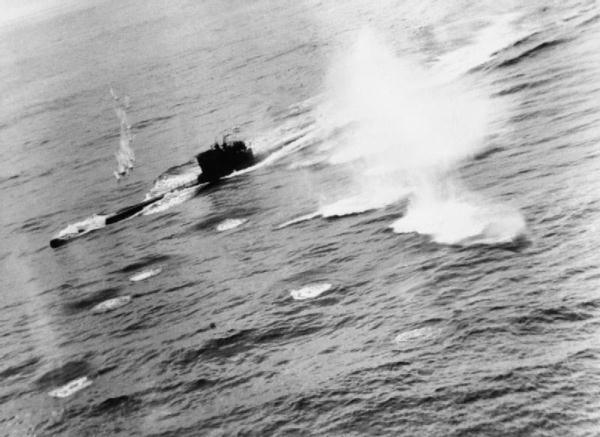
Brace yourselves, history fans. With the approach of the 70th anniversary of the 1944 Normandy Invasion this Friday, the media is a-buzz with D-Day backgrounders, retrospectives and first-hand accounts from those who were there. Spoiler alert: you may even see coverage here in the coming days. But with the press consumed with all things Overlord, many other June 6 military milestones will be overlooked. That’s where we come in. Consider these:
Payback in the Pacific
Two years to the day prior to the Allied landings in France, the U.S. Navy was in the fight of its life against a Japanese armada off Midway Island. The four-day battle, which took place just six months after Pearl Harbor, saw an American fleet ambush and sink four of the six enemy carriers that took part in the infamous Dec. 7 raid. More than 3,000 casualties were inflicted on Isoroku Yamamoto’s task force in the decisive battle. Japan also left the encounter with 250 fewer warplanes. The cost to the United States was less severe: 300 sailors and airmen killed and 150 aircraft destroyed. The carrier USS Yorktown was also lost. After Midway, America would score follow-up victories in the Pacific putting Japan on the defensive for the rest of the war.

A Dark Day for the Allies
June 6 in 1940 was disastrous for the Allies. As part of the month-old Nazi invasion of France, legendary panzer general Irwin Rommel would crash through the Allied lines between Abeville and Amiens. Within 16 days, the French would surrender. At almost the same moment, more than 15,000 British and French troops would be evacuated from Norway as that country fell to the Nazi juggernaut. Also on June 6, Germany’s U-46 torpedoed HMS Carinthia off western Ireland. The vessel would survive the initial attack, but sink hours later.

Bloody Belleau Wood
Twenty-six years before D-Day, the U.S. Marines were kicking off a three week-long battle in France at Belleau Wood. It was one of America’s first major engagements of the First World War. On June 6, 1918, two companies of leathernecks from the 1st Battalion, supported by the 167th French infantry division charged heavily fortified German positions on Hill 142 near Belleau. Although the attacking force was almost entirely obliterated, a handful of Americans managed to hold the line in the face determined counter attacks. Later that same day, Marines would storm the forest itself taking 1,000 casualties in mostly hand-to-hand combat. During the clash, one Medal of Honor-winning Marine sergeant by the name of Dan Daly famously urged his men forward by shouting: “Come on, you sons of bitches, do you want to live forever?”

Battle of Memphis
One hundred and fifty two years ago this Friday, a fleet of Union ironclads crushed a rag-tag Rebel fleet on the Mississippi at Memphis. The victory gave the North control over the strategically vital inland waterway.

The June Rebellion
The Paris uprising that inspired Victor Hugo’s Les Misérables was fought between June 5 and 7 in 1832. The unrest began when reform-minded republicans mounted an insurrection to overturn France’s two-year-old constitutional monarchy of Louis Philippe I. It took three days for national troops to quell the uprising. Nearly 1,000 casualties resulted. Hugo witnessed the strife first hand and published his landmark opus 30 years later.

Manifest Destiny Dreams Dashed
Much of Canada might very well be an American state today had a U.S. invasion not been decisively thwarted in a farmer’s field at Stoney Creek, Ontario on June 6, 1813. After capturing the Niagara Peninsula in May, an army of 3,400 U.S. regulars and militia under the command of Gen. John Chandler pressed on to take the capital of York (present-day Toronto) to end the year-old War of 1812. But as the invaders slept that night, a column of 700 British redcoats with bayonets fixed struck the American camp in the pre-dawn darkness. Despite the ferocity of the ensuing hour-long clash, casualties were surprisingly light. All told, the U.S. lost fewer than 20 dead, but the British did manage to capture Chandler along with 100 troops. Reeling from the shock of the raid, the Americans abandoned their summer campaign to seize the colony.

Other June 6th Battles
• Following a two-week siege in 1781, American forces under Gen. Andrew Pickens and “Light Horse Harry” Lee, father of the legendary Civil War commander, finally took control of the Tory stronghold of Augusta, Georgia on the sixth day of June.
• Speaking of sieges, exactly 19 years earlier, the British inaugurated a two-month blockade of Havana. By Aug. 13, 1762, the city fell to 30,000 redcoats, sailors and marines under the command of George Keppel, aka 3rd Earl of Albemarle. It was a significant blow to Spanish prestige in the New World. The Cuban capital was returned the following year as part of the Treaty of Paris, which ended the Seven Years War.
• Closer to our own era, June 6, 1982 was also the day that Israeli forces invaded Lebanon. The move touched off a three-year occupation of the troubled Middle Eastern country. Before it was over, more than 4,000 Israeli troops would be casualties, along with 19,000 Syrians and Palestinians.










Thank you for the detailed information about the Battle of Midway. Having just read part of Stephen L. Moore’s “Pacific Payback” I was trying to determine how many SBD’s took part, even the ones that dropped their bomb load early due to their faulty switches. The Dauntless, the P-40 (God is My Co-Pilot) and the British Mosquito are my favourite WW II aircraft in building model airplanes from plastic kits and I’m a senior born in 1946.